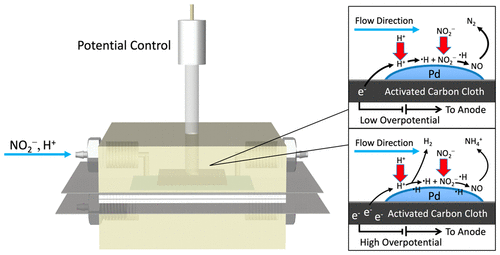当前位置:
X-MOL 学术
›
ACS ES&T Eng.
›
论文详情
Our official English website, www.x-mol.net, welcomes your
feedback! (Note: you will need to create a separate account there.)
Scalable Reactor Design for Electrocatalytic Nitrite Reduction with Minimal Mass Transfer Limitations
ACS ES&T Engineering ( IF 7.4 ) Pub Date : 2020-11-16 , DOI: 10.1021/acsestengg.0c00054 Chenxu Yan 1 , Sruthi Kakuturu 1 , Ashley Hesterberg Butzlaff 2 , David M. Cwiertny 2, 3 , Syed Mubeen 3 , Charles J. Werth 1
ACS ES&T Engineering ( IF 7.4 ) Pub Date : 2020-11-16 , DOI: 10.1021/acsestengg.0c00054 Chenxu Yan 1 , Sruthi Kakuturu 1 , Ashley Hesterberg Butzlaff 2 , David M. Cwiertny 2, 3 , Syed Mubeen 3 , Charles J. Werth 1
Affiliation

|
A parallel-plate thin-layer (PPTL) flow reactor with potential control and custom-made cathode of Pd–In modified activated carbon cloth was developed for electrocatalytic removal of nitrite from water; the effect of applied potential and flow rate were investigated. Compared to other reactors in the literature, rapid nitrite reduction (first-order rate constant is 0.38 L gPd–1 min–1), high current efficiency (CE, 51%), and low ammonium selectivity (5.4%) were observed at an applied potential of −0.60 V vs the Ag/AgCl reference electrode (RE) and a flow rate of 40 mL min–1 in a phosphate buffer solution of pH 6.5. Slightly faster kinetics were observed at more negative potentials (0.57 L gPd–1 min–1 at −1.0 V/RE), but then ammonium production (88%), H2 gas evolution (E0 = −0.61 V/RE), and current loss (CE < 10%) became problematic. Nitrite reduction was measured in the PPTL flow reactor for almost 50 2 h cycles over six months, with little apparent loss (30%) in activity. A reactive transport model was developed and used to simulate the kinetic data. The fitted intrinsic rate constant (kw) was 5.2 × 10–6 m s–1, and ratios of dimensionless Nusselt numbers to reaction rate constant values support the reactor being more reaction than mass transfer limited. Application of the parametrized model demonstrated how the PPTL reactor could be scaled (e.g., cathode dimensions, flow channel thickness), operated (i.e., flow rate), or modified (i.e., greater intrinsic catalyst activity) to most efficiently remove nitrite from larger flow streams.
中文翻译:

具有最小传质限制的电催化亚硝酸盐还原的可扩展反应器设计
开发了具有电位控制和定制Pd-In改性活性炭布阴极的平行板薄层(PPTL)流动反应器,用于电催化去除水中的亚硝酸盐。研究了施加电势和流速的影响。与文献中的其他反应器相比,在以下条件下观察到亚硝酸盐快速还原(一级速率常数为0.38 L g Pd –1 min –1),高电流效率(CE,51%)和低铵选择性(5.4%)。与Ag / AgCl参比电极(RE)相比,施加的电位为−0.60 V,在pH 6.5的磷酸盐缓冲溶液中的流速为40 mL min –1。在更多负电势下观察到动力学稍快(0.57 L g Pd –1 min-1 -1.0 V / RE),但随后铵生产(88%),H 2气体放出(Ë 0 = -0.61 V / RE),和电流损失(CE <10%)成为问题。在六个月的时间里,在PPTL流动反应器中测量了近50个2 h循环中的亚硝酸盐还原,几乎没有活性损失(30%)。开发了反应性运输模型并用于模拟动力学数据。拟合的固有速率常数(k w)为5.2×10 –6 ms –1,无量纲的Nusselt数与反应速率常数值的比值支持反应器比传质受限的反应更多。参数化模型的应用展示了如何调整PPTL反应器的尺寸(例如,阴极尺寸,流道厚度),运行(即,流速)或进行修改(即,更高的固有催化剂活性),以最有效地从较大流量中去除亚硝酸盐流。
更新日期:2020-11-16
中文翻译:

具有最小传质限制的电催化亚硝酸盐还原的可扩展反应器设计
开发了具有电位控制和定制Pd-In改性活性炭布阴极的平行板薄层(PPTL)流动反应器,用于电催化去除水中的亚硝酸盐。研究了施加电势和流速的影响。与文献中的其他反应器相比,在以下条件下观察到亚硝酸盐快速还原(一级速率常数为0.38 L g Pd –1 min –1),高电流效率(CE,51%)和低铵选择性(5.4%)。与Ag / AgCl参比电极(RE)相比,施加的电位为−0.60 V,在pH 6.5的磷酸盐缓冲溶液中的流速为40 mL min –1。在更多负电势下观察到动力学稍快(0.57 L g Pd –1 min-1 -1.0 V / RE),但随后铵生产(88%),H 2气体放出(Ë 0 = -0.61 V / RE),和电流损失(CE <10%)成为问题。在六个月的时间里,在PPTL流动反应器中测量了近50个2 h循环中的亚硝酸盐还原,几乎没有活性损失(30%)。开发了反应性运输模型并用于模拟动力学数据。拟合的固有速率常数(k w)为5.2×10 –6 ms –1,无量纲的Nusselt数与反应速率常数值的比值支持反应器比传质受限的反应更多。参数化模型的应用展示了如何调整PPTL反应器的尺寸(例如,阴极尺寸,流道厚度),运行(即,流速)或进行修改(即,更高的固有催化剂活性),以最有效地从较大流量中去除亚硝酸盐流。











































 京公网安备 11010802027423号
京公网安备 11010802027423号